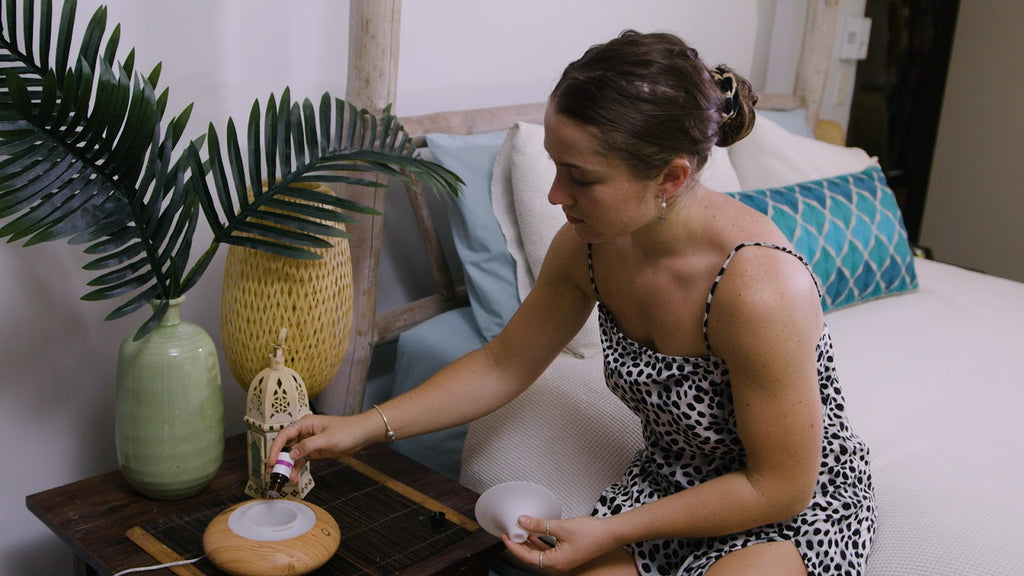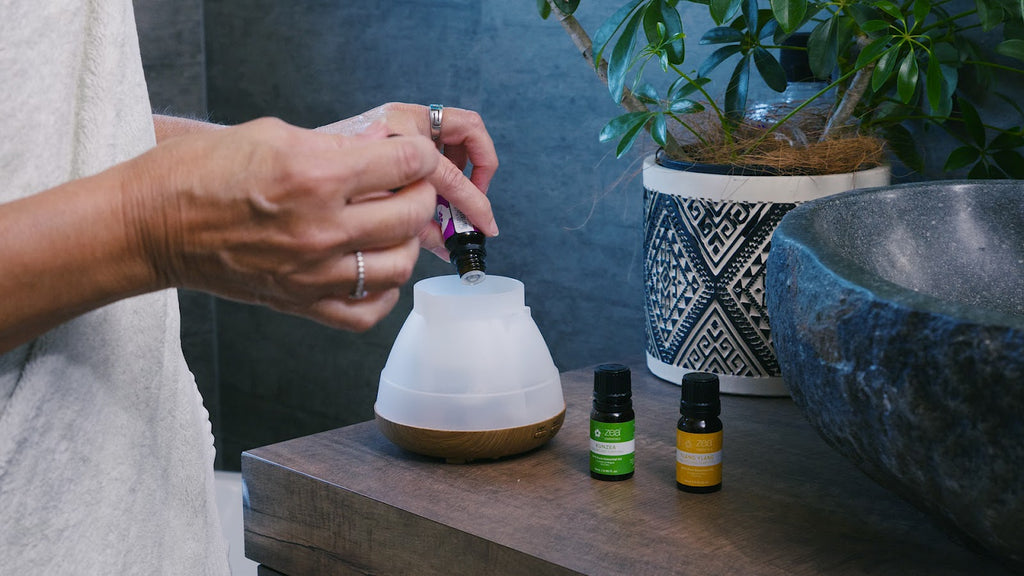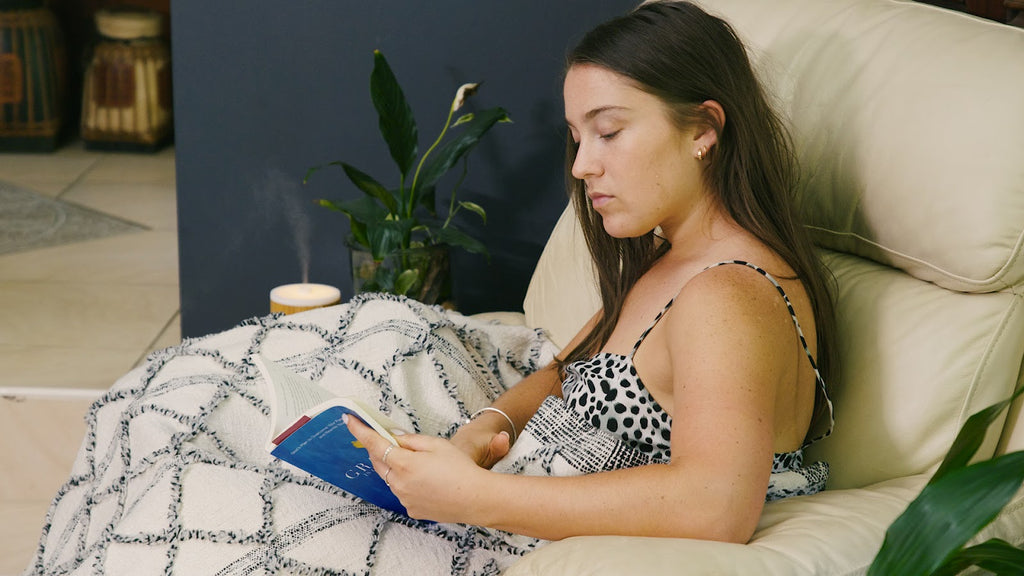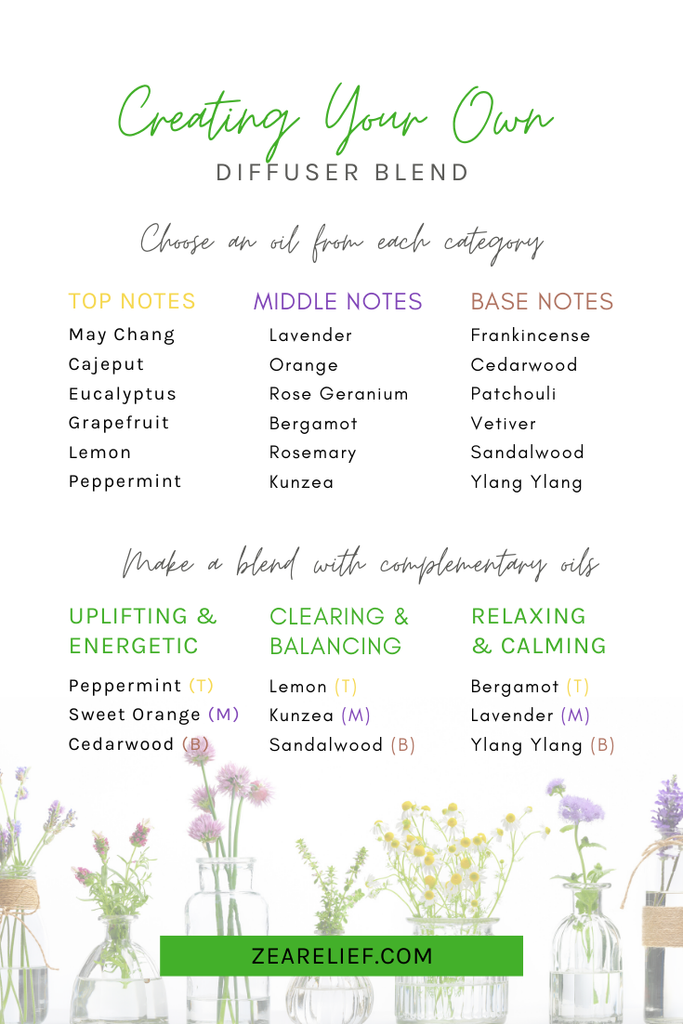A great thing about aromatherapy is how diverse essential oils are. Not only for their benefits to support pain management, emotional and mental health, and general wellbeing, but in the different ways we can use aromatherapy to receive those benefits.
By far, one of the most popular ways to use essential oils is by diffusing single oils or blends to disperse the scent safely into the air (but if you’re looking for other ways to use your oils, you can read about them in our Essential Oils 101 guide).
What is an Aromatherapy Diffuser?
There are a number of different kinds of essential oil diffusers, such as an atomising diffuser (or nebuliser), steam diffuser, or fan diffuser, but an ultrasonic diffuser is a common and often preferred way to diffuse oils.
An ultrasonic diffuser works with water as a transference mechanism and, therefore, does not rely on heat or steam. You simply fill the diffuser with tap water and add a couple of drops of your preferred oil to the water. Turn it on and it will create a fine mist continually or, if preferred, intermittently over a period of time.
The mist that filtrates through the room is a cool-mist containing drops of essential oils broken down into their base molecules, dispersed in a cool-mist for safety and efficacy.
Diffusion, or rather inhalation, is often considered the safest method of using essential oils.
Why Is Inhalation of Essential Oils Effective?
The olfactory system refers to all the organs and cells that affect our sense of smell. When we inhale airborne molecules through our nose, they are distributed almost immediately to the brain, the respiratory system, and the limbic system (our emotional brain).
When we are stressed or experiencing emotions, this is usually due to an activation of our limbic brain, which controls our heart rate, blood pressure, breathing, memory, stress levels, and hormones2.
Research suggests that inhaling essential oils with specific properties and benefits can reach a number of our systems at once and also interact with and benefit our emotions, depending on the oil and its properties2.

Benefits of an Aromatherapy Diffuser
There are many reasons to use a diffuser to make the most of your essential oils and get maximum benefits from them.
1. Safer and More Effective Than Oil Burners
Oil burners are cost-effective and can create a beautiful ambiance in a room, however, unlike a diffuser, oil burners require a naked flame which creates an associated risk of fire. This also means they cannot be used in public spaces where they could have huge benefits, such as in classrooms, workplaces, or hospitals.
Another important thing to note is that - unlike diffusers - oil burners distribute the scent of your oils using heat. However, when heat is applied to essential oils, the properties of that oil may change and be less effective, a little like when you cook food.
“Essential oils are not super fragile, but one way to degrade essential oils is to heat them up. The main factors responsible for essential oil degradation are oxygen, heat and light”2.
2. Added Health And Wellness Benefits
Ultrasonic diffusers work like a cold humidifier, adding extra moisture to the air, especially during winter or “coughs and colds” season. By dispersing the essential oil droplets into the air it enables us to inhale easily and safely, provide a beautiful aroma and purify the air, helping to rid of unpleasant odours and remove toxins and bacteria.
Some diffusers also work as an ioniser as well as a humidifier, therefore adding to the health benefits of the essential oils being diffused.

3. Make The Most Of Your Essential Oils
Essential oils are highly concentrated, and a few drops can go a long way to distribute the aroma and benefits of your chosen oil to the whole room.
You only need 2-6 drops in total in your diffuser to achieve your desired outcome - although this is dependent on the size of the room and water capacity of the diffuser.
If you are blending three different essential oils together for relaxation, you would only use 1-2 drops of each, but everyone in the room will receive the benefits.
4. Easy To Use And Maintain
Diffusers are easy to clean and most models turn themselves off automatically.
To clean your diffuser, simply rinse with water and a drop of dishwashing detergent and wipe dry after each use, making sure to clean the sensor with a soft cloth or cotton bud.
Depending on how often you use your diffuser, it is also a good idea to give it a thorough clean once a week or every so often with fresh water and a tablespoon of vinegar. Diffuse for 5-10 minutes (or up to 30 minutes).

5. Set the Mood and Atmosphere Of The Room
Many diffusers work as a night light and often have a choice of colours that you can programme to enhance your mood and atmosphere by activating another one of the five senses.
Selecting the colour of lights you prefer, alongside a thoughtful selection of oils can help set the mood you’re after.
For example, you might like a blue or purple colour for relaxation when diffusing Lavender or our Calming Blend. During the day, you might set your diffuser to a bright yellow or white, while diffusing a more energising blend, to feel motivated to get things done. Or, maybe selecting a red or pink light whilst diffusing our Aphrodisiac Blend for a romantic night in.
Create Your Own Diffuser Blend
The versatility of a diffuser, means that you can get creative with which oils to blend. You might like to try our beautiful Lifestyle Blends or make your own.
Blending your own essential oil may seem overwhelming at first, so a great way to get started is by learning the different blending factors - top notes, middle notes, and base notes.
Essential oils are categorised this way based on the rate that they evaporate - top notes more quickly, and base notes more slowly. This will affect how your blend diffuses, the top notes will initially be the most obvious scents, and the base notes will take longer to come through3.
Below are a few essential oils from each category that are commonly used in blends so you can have fun with creating different effects and atmospheres with your diffuser.
When creating your own blends it is nice to explore the diversity of essential oils, although a good place to start is including an essential oil from each note.
Experiment, enjoy your creations, and have fun with your essential oils and your Aromatherapy Diffuser.
Have Fun Creating Your Unique Blends
Remember, when it comes to creating and diffusing your own essential oil blends, it all comes down to trial and error. Essential oils are as unique as you are and everyone has different tastes, just like with food, perfumes, and all aspects of life.
Have fun until you find your own special blend and if you’re looking for inspiration, follow us over on Pinterest, where you can pin our favourite blend recipes to try out.
About the Author - Michelle Brass ND
With over 25 years of experience in the natural health industry, Michelle has dedicated her life to helping others embrace the therapeutic benefits of nature. Throughout her time as a health practitioner, she has used and recommended countless traditional and conventional treatments to her clients - as she believes an integrative approach to health and wellness is very important. Michelle is passionate about using and promoting essential oils and, in particular, Kunzea Oil, as she has seen them help thousands of people over the years. She knows that using essential oils in your daily life can help bring balance to the mind, body and soul. She is constantly trialling and testing new products with her loyal clients.
To learn more about Michelle, go to her full bio page.
References
-
University of Minnesota. How Do Essential Oils Work? https://www.takingcharge.csh.umn.edu/explore-healing-practices/aromatherapy/how-do-essential-oils-work Accessed 11 June 2020.
-
Battaglia S. The Complete Guide To Aromatherapy. 3rd ed. Black Pepper Creative Pty Ltd; 2018.
-
Peterson, D. American College of Healthcare Sciences. Blending 101: The Art of Pairing https://info.achs.edu/blog/blending-101-the-art-of-pairing Accessed 11 June 2020.




